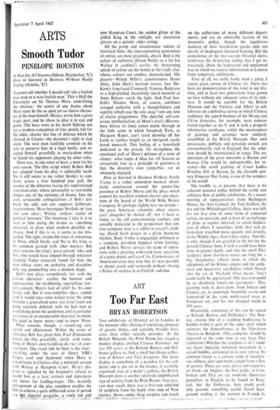Too Far East
ART BRYAN ROBERTSON
Two exhibitions of Oriental art in London at the moment offer alluring if tantalising glimpses of greater things, and certainly broader hori- zons, than either actually provides. At the British Museum, the Print Room has staged a modest display entitled Chinese Paintings: the last 300 years; at the Roland, Browse and Del- banco gallery we find a small but choice collec- tion of Khmer and Thai Sculpture. The latter display is something of a paradise for the col- lector and is put on in the chancy, if carefully organised, way of a dealer's gallery; the British Museum show is another relatively unpublicised sign of activity from the Print Room—last year, you may recall, there wash first-rate selection of sculpture from the Sepik river area of New Guinea. Shows under these auspices can touch
on the collections of many different depart- ments, and are an admirable feature of the museum's policy, though the lugubrious modesty of their installation speaks only too clearly of inadequate financial backing. But the coincidence of the two current Oriental shows reinforces the despairing feeling that I get in- creasingly about the haphazard and unplanned way in which we receive information in London from temporary exhibitions.
First of all, we really badly need a great, 1 repeat great, survey of Chinese art. There has been no demonstration of this kind in my life- time, and at least two generations have grown up here without any adequate sense of its rich-
ness. It would be sensible for the British Museum and the Victoria and Albert to col-
laborate on a definitive survey in which Chinese sculpture, the superb bronzes of the Sh`ang and Ch'ou dynasties, for example, were concen- trated together at the V and A with a properly informative catalogue, whilst the masterpieces of painting and ceramics were similarly
assembled at the British Museum. Our own possessions, publicly and privately owned, are extraordinarily rich in England, but the selec- tion should be international in range. The co- operation of the great museums at Boston and Kansas City would be indispensable, for in- stance—the scroll painting of Court Ladies Winding Silk at Boston, by the eleventh cen- tury Emperor Hui Tsong, is one of the wonders of the world.
The trouble is, at present, that there is no coherent national policy behind the costly and arbitrary flow of public exhibitions. At a recent meeting of representatives from Burlington House, the Arts Council, the Tate Gallery, the ICA and the Whitechapel Gallery, there was talk for the first time of some form of concerted action, on occasion, and at least of an exchange of plans at regular intervals to avoid duplica- tion of effort. I sometimes think that real in- formation travelled more quickly and directly, in the Middle Ages, than it does today. And this is why, though I am grateful to the Dm for the present Chinese show, I wish it could have been done in greater depth; and why the small Thai sculpture show elsewhere makes me long for a big, imaginative, official show, in which the splendours of the Khmer empire and the sculp- tural and decorative sensibilities which flowed into the art of Thailand (Thai means 'free') could really be appreciated. This occasion could be an absolutely knock-out eye-opener: Thai painting with its derivations from Indian and Chinese art, is stunningly beautiful, warm and humanised in the same multi-racial ways as Pompeian art, and has not changed much in 500 years.
Meanwhile, something of this can be sensed at Roland, Browse and Delbanco's. The flow- ing, sinuous line of a standing bodhisatva (a buddha-to-be) is part of the same spirit which animates the dance-dramas at the Silprakorn Theatre in Bangkok. (This company should be imported at the same time as any large Thai exhibition.) Whether the sculpture is of a stand- ing figure implying imminent movement or a seated buddha, entranced in its own repose, the common factor is a curious kind of mischiev— ous stillness, alert and intent, caught from a flow of gesture. There are some glossy and expensive art books on Angkor; the best guides to Cam. bodian and Thai art are modestly illustrated pamphlets in English to be found in Bang. kok, but the Embassies here could prob- ably provide somethitig useful. Good back- ground reading is the journal in French by v,11,1tAC,14.00(.90, / 3C 364/ Pierre Loti, one of the first Europeans to visit this mysterious civilisation in the jungle after 400 years of inaccessibility—and long before the intrepid M Malraux was arrested while attempting to remove some of the best temple sculpture to France.
There is very little else to say about the am show except that, if the intention was to show the sad decline of Chinese art during the past 300 years, complete success has been achieved. There is nothing at all to compare with the life- sized Goddess of Poverty at the far end of the exhibition room where some sculptures and paintings of more ancient periods have been placed together to make a contrast to the show itself. This single sculpture, the Sung ducks, the Yuan painting of birds and willows, and the highly coloured life-sized seated monk sculp- ture from a cave-temple are more than worth the journey to Bloomsbury.































 Previous page
Previous page